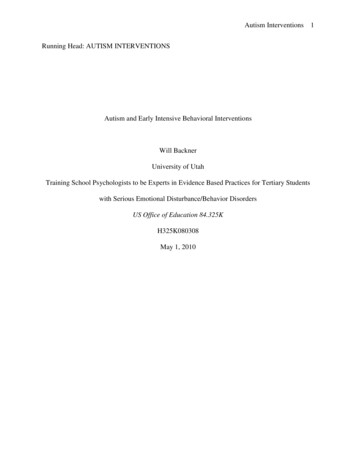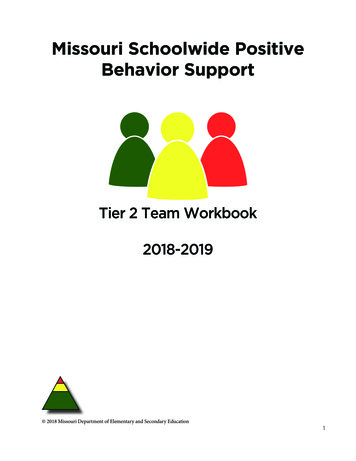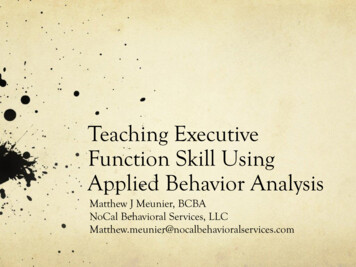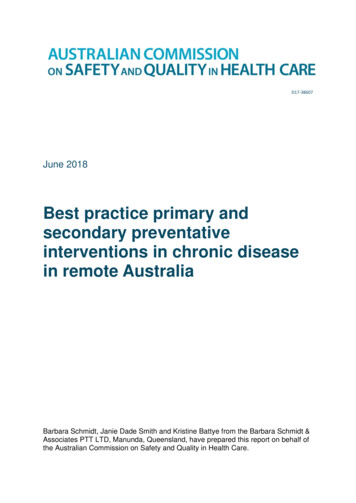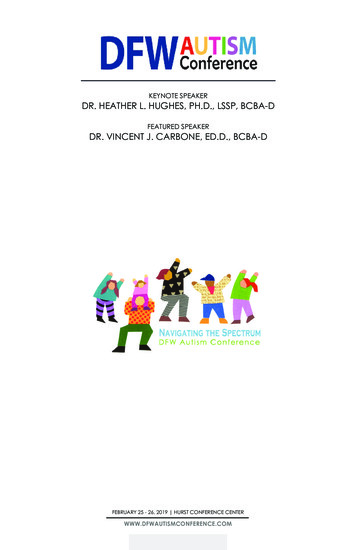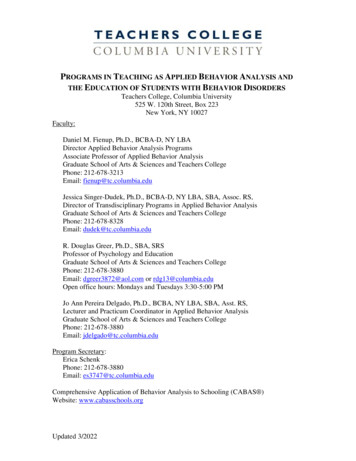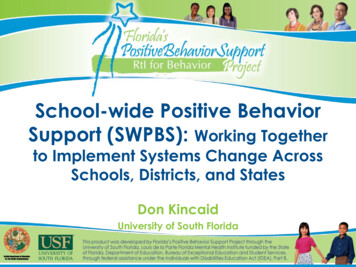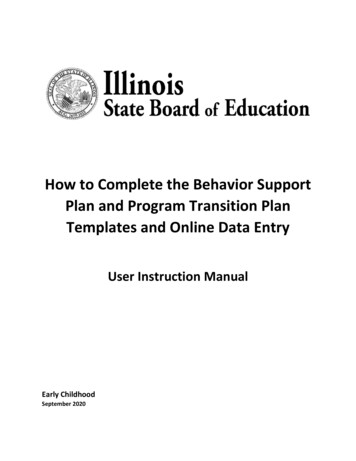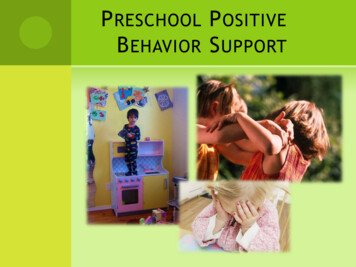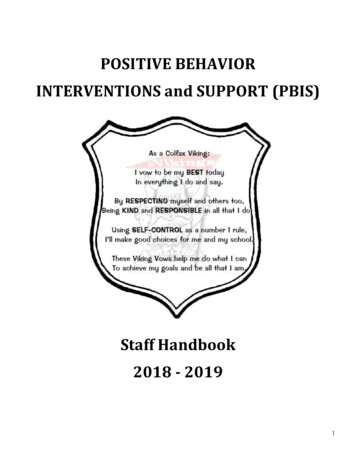
Transcription
POSITIVE BEHAVIORINTERVENTIONS and SUPPORT (PBIS)Staff Handbook2018 - 20191
ContentsPBIS Goal . 5PIBS Team . 5Internal Coach/Facilitator: . 5Recorder:. 5Data Coordinator: . 5Time Keeper/Rudder:. 5Communications: . 6Encourager: . 6Parent Team Members: . 6External Coach: . 6Administrators: . 6Common Area Policies . 7Common Area: Cafeteria. 7Common Area: Hallway . 8Common Area: Playground . 9Common Area: Restroom . 10PBIS Teaching Schedule for 2018 - 2019 . 13Colfax Elementary Cafeteria Lesson Plans . 14Lesson 1: Entering Cafeteria (20 min) . 14Lesson 2: Table Manners in Cafeteria (20 min) . 14Lesson 3: Cleaning and Exiting Cafeteria (20 min) . 15Colfax Elementary Restroom Lesson Plans . 16Lesson 1: Respect Myself and Others (20 min). 16Lesson 2: Overview and Procedures (20 min) . 16Colfax Elementary Dismissal Lesson Plan. 182
Lesson 1: Overview and Procedures (20 min) . 18Colfax Elementary “Riding on the Bus” Lesson Plan . 19Lesson 1: Safety on the Bus (25 min) . 19Lesson 2: Safety Exiting the Bus (25 min). 19Colfax Elementary Hallway Lesson Plans . 21Lesson 1: Overview (20 min) . 21Lesson 2: Voice Levels (25 min). 21Lesson 3: Movement (20 min) . 22Lesson 4: Responsibility (15-20 min) . 23Colfax Elementary Playground Lesson Plans . 25Lesson 1: Overview and Procedures (25 min) . 25Lesson 2: Respect Myself and Others (25 min). 25Colfax Elementary Vow: School Wide Expectations Lesson Plans. 26Lesson 1: Overview (20 min) . 26Lesson 2: Use Self Control (20 min). 27Lesson 3: Take Responsibility . 27Lesson 4: Respect Myself and Others (20 min). 27Lesson 5: Showing Kindness to Others (20 min) . 28Colfax Elementary School-Wide Encouragement Plan . 29Type of Acknowledgement: Individual Students . 29Viking BEST Shields/Students of the Month . 29Type of Acknowledgement: Individual Students/Whole School . 29School Wide School Store . 29Type of Acknowledgement: Classroom . 29Viking Class of the Week Banner. 29Type of Acknowledgement: Staff Recognitions . 293
Type of Acknowledgement: Buses . 30PBIS Viking Shields . 31GCS Positive Behavior Intervention and Support . 32Menu of Teacher Responses . 32Pre-correction . 32Proximity Management . 32Verbal Reminder . 32Change in Location . 33Positive Practice . 33Brief Delay . 33Time Owed . 33Time Out . 34Write Down Exactly What Was Said . 35Discussion . 35Restitution . 35Problem Solving/Debriefing . 36Count/Chart the Misbehavior. 36Planned Ignoring of Inappropriate Behavior –Warning: Difficult to do well! . 36Contact Parents . 37Report to Office/Other School Staff . 37Office Referral . 38Colfax Office Referral Levels of Misbehavior . 39Minor vs. Major Referrals . 43Colfax Elementary Behavior Referral Flow Chart . 444
PBIS GoalPositive Behavior Interventions and Support sets the stage for a positive, predictable, consistentand safe environment by proactively establishing and teaching Colfax’s values regardingbehavior.The ultimate goal is for students to internalize these values, i.e., to do something because it is the right thingto do. At Colfax, we will begin this process by explicitly naming the values and character traits we want forour students and staff.PIBS TeamKindergarten: Sarah Jimenez1st Grade: Bethany Cline2nd Grade: Melissa Van Wert3rd Grade: Cheryl Shaw4th Grade: Jenny Rathjen5th Grade: Nicole SheltonEC Staff: Maura Cost/Kim Fulp/Amber Balicki/Shawnee EllsworthSpecialist: Cinda Krueger/Chuck Blair (Tier 2 chair)Administration: Julie Kimsey/Shelton MorganExternal Coach: Jenilee FleetwoodRolesInternal Coach/Facilitator: Creates agenda;Facilitates meeting;Make sure meetings begin and end on time;Follows up with information to the administrator.Recorder: Types minutes at meeting;Updates goal plans at meeting;Sends out minutes for team;Sends out reminder for next meeting.Data Coordinator: Make sure office discipline referrals (ODRs) are consistently entered into the SWIS system;Makes SWIS reports available to the PBIS team at least once a month;Helps team implement data driven decision making process (TIPS).Time Keeper/Rudder: Reminds team members of time constraints;Allows for specified time per agenda item;5
Redirects team members when topic strays.Communications: Make sure communication systems and practices are established and maintained with staff,students, families, and community.Encourager: Helps keep meetings positive;Encourages all team members to participate;Identifies something and someone to celebrate.Parent Team Members: Provides the team with perspective of the parents and the community;Provides additional support with implementing PBIS practices (e.g., Parents can assist withplanning and delivery with incentives/celebrations.External Coach: Serves as liaison between district/state level PBIS efforts and the school;Attends team meetings;Assist with trainings and presentations;Provides resources, support, and technical decisions.Administrators: Attends all trainings and team meetings;Provides allocation of resources for PBIS implementation;Puts time on staff agenda for PBIS updates;Actively promotes PBIS as priority, integrates with other incentives/improvement activities;Identifies how to free staff time for participation on the PBIS team;Makes sure the schedule meeting dates and times are on the calendar;Reminds staff of significant impact and ultimate success;Actively encourages team efforts, provides planning time, feedback, and supporting initiatives.6
Common Area PoliciesCommon Area: CafeteriaPart 1: GOALThe cafeteria will be a safe and clean environment where all students and staff interact with courtesy andrespect.Part 2: RULES/PROCEDURES FOR STUDENT BEHAVIOR Students will walk in a silent line and go through the lunch line using a voice level 0. Students will get all utensils, condiments, and food items while in line. Students will remain seated and raise hand if need assistance. Students will keep all hands, objects and food to themselves. Students will use your manners at all times. Students will be prepared to order, eat in a timely manner, pick up after themselves, and dispose of alltrash appropriately.Part 3: SUPERVISION RESPONSIBILITIES Teachers will walk their students to the cafeteria. Once students are halfway through the line, teachers may leave when the supervising staff member ispresent. Supervising staff will report on time for lunch duty. All staff will positively reinforce student expectations for cafeteria by handing out Viking BESTshields.PART 4: ENCOURAGEMENT PROCEDURES Faculty and Staff will engage in positive interaction with students at all times (i.e. eye contact, smiling,and non-verbal praise). Faculty and staff will give verbal praise to students and groups of students for following thebehavioral expectations in the cafeteria. Faculty and staff will give students positive feedback about specific behaviors that are contributing tothat student’s success; such as, “Zack, I appreciate how you disposed of your trash from the cafeteriaand lined up quietly.” Faculty will implement and follow the School Wide Encouragement Plan when acknowledgingappropriate behaviors (Viking BEST shields). Part 5: TEACHER RESPONSES TO INFRACTIONS Faculty and staff will intervene early to proactively discourage student misbehavior (non-verbalsignal/making eye contact). Student misbehavior should initially be redirected by giving a verbal reminder of appropriatebehavior. Staff will implement consequences for continued student misbehavior, such as a loss of free time,cleaning up ones mess, going to the back of the line, and assigned seat (silent lunch can only beassigned by administration). Faculty and staff will follow the Office Discipline Referral Process for documenting chronic offenses.7
Common Area: HallwayPart 1: GOALThe hallway of Colfax Elementary will be safe, friendly, and orderly environment where everyoneinteracts with courtesy and respect.Part 2: RULES/PROCEDURES FOR STUDENT BEHAVIOR Students will walk silently on the right hand side of the hall and on the second square. Students will keep their hands and feet to themselves. Students will maintain their personal space. Students will walk directly to their destination. Students will follow adult directions the first time.Part 3: SUPERVISION RESPONSIBILITIES Staff will follow student expectations for hallway behavior, including walk on right, speaking quietly,and using right side of double doors. All staff will interact positively with students in the hallways (non-verbal sign). All staff will monitor and correct misbehaviors in hallways immediately with positive reinforcement,while using a level 1 voice. Staff will acknowledge any and all students/classes following the hallway policy. Staff will handout individual shields and class shields when appropriate (following expectations)PART 4: ENCOURAGEMENT PROCEDURES Faculty and Staff will engage in positive interaction such as eye contact, smiling, and non-verbalpraise. Faculty and staff will give verbal praise to students and groups of students for following thebehavioral expectations in the hallways. Faculty and staff will give students positive feedback about specific behaviors that are contributing tothat student’s success; such as, “Emma, I notice that you are walking into the cafeteria and I want tothank you for your responsible behavior.” Faculty will implement and follow the School Wide Encouragement Plan when acknowledgingappropriate behaviors (Viking BEST shields).Part 5: TEACHER RESPONSES TO INFRACTIONS Faculty and staff will intervene early to proactively discourage student misbehavior (non-verbalsignal/making eye contact). Student misbehavior should initially be redirected by giving a verbal reminder of appropriatebehavior. Staff will ask students who do not respond to a verbal reminder to practice the responsible behavior. Staff will tell a student who refuses to follow a staff member’s direction (or is verbally argumentative/noncompliant), that he/she can choose to follow the direction or he/she will be referred to the Officefor noncompliance. Staff should not attempt to make a student comply by physically moving him/her.8
Common Area: PlaygroundPart 1: GOALThe students at Colfax Elementary will play safely in all games and on all equipment.Part 2: RULES/PROCEDURES FOR STUDENT BEHAVIOR Students will play gently with others by keeping hands, feet, and objects to themselves. Students will leave rocks, bark, sticks, and other dangerous objects alone. Two finger tag and othergames are permitted. Games where students are the target should not be played (example: dodgeball). Students will keep playground free of trash. Students will treat others as they want to be treated. Students will share equipment, include others in games, and use good sportsmanship. Students will use playground equipment for the purpose it was designed for.Part 3: SUPERVISION RESPONSIBILITIES Teachers will actively supervise their students while on the playground. Teachers will circulate among their students and avoid standing in one place. Teachers will monitor and correct student misbehavior on the playground. Teachers will follow the attached crisis plan for emergencies on the playground.PART 4: ENCOURAGEMENT PROCEDURES Faculty and Staff will engage in positive interaction such as eye contact, smiling, and non-verbalpraise. Faculty and staff will give verbal praise to students and groups of students for following thebehavioral expectations on the playground. Faculty and staff will give students positive feedback about specific behaviors that are contributing tothat student’s success; such as, “Zack, I like how you play with the equipment properly and showedgood sportsmanship. Faculty will implement and follow the School Wide Encouragement Plan when acknowledgingappropriate behaviors (Viking BEST shields).Part 5: TEACHER RESPONSES TO INFRACTIONS Faculty and staff will intervene early to proactively discourage student misbehavior (non-verbalsignal/making eye contact/whistle). Student misbehavior should initially be redirected by giving a verbal reminder of appropriatebehavior. Staff will implement consequences for continued student misbehavior, such as using playgroundequipment inappropriately and noncompliance. Faculty and staff will follow the Office Discipline Referral Process for documenting chronic offenses.9
Common Area: RestroomPart 1: GOALStudents at Colfax Elementary will keep the restroom clean, quiet, and safe.Part 2: RULES/PROCEDURES FOR STUDENT BEHAVIOR All students will leave stall unlocked after use and leave the restroom clean. Students will be quick, quiet, and leave the restroom clean. All students will keep restroom free of trash and graffiti. Students will use one pump of soap, keep feet on the floor, and use/dispose of one paper towel. Students will not take instructional supplies into the restroom areas.Part 3: SUPERVISION RESPONSIBILITIES Teachers and/or assistants will escort students to the restrooms when going as a class. Staff will give passes to students excused from class to go to the restroom (ACES group leaders willsupervise students at all times). Staff in hallways will ask students to see their pass. Staff will check restrooms after use to ensure restroom procedures are being followed.PART 4: ENCOURAGEMENT PROCEDURES Faculty and Staff will engage in positive interaction such as eye contact, smiling, and non-verbalpraise. Faculty and staff will give verbal praise to students and groups of students for following thebehavioral expectations in the restrooms. Faculty and staff will give students positive feedback about specific behaviors that are contributing tothat student’s success; such as, “Zack, I appreciate that you returned from the restroom in a timelymanner.” Faculty will implement and follow the School Wide Encouragement Plan when acknowledgingappropriate behaviors (Viking BEST shields).Part 5: TEACHER RESPONSES TO INFRACTIONS Faculty and staff will intervene early to proactively discourage student misbehavior (non-verbalsignal/making eye contact). Student misbehavior should initially be redirected by giving a verbal reminder of appropriatebehavior. Staff will implement consequences for continued student misbehavior, such as an assignment of arestroom monitor, loss of free time, and cleaning up ones mess. Faculty and staff will follow the Office Discipline Referral Process for documenting chronic offenses.10
Staff ExpectationsColfax Elementary SchoolHallwayCafeteria Staff will model Teachers willstudentwalk theirexpectationsstudents to thefor hallwaycafeteria.behavior bywalking on the Once studentsright, speakingare halfwayquietly andthrough theusing right sideline, teachersof doublemay leavedoors.when thesupervising All staff willstaff member isinteractpresent.positively withstudents in the Supervisinghallways (nonstaff will reportverbal sign).on time forlunch duty. All staff willmonitor and All staff willcorrectpositivelymisbehaviorsreinforcein hallwaysstudentimmediatelyexpectationswith positivefor cafeteria byreinforcement,handing outwhile using atickets tovoice level 1.students whoare using avoice level 2 orlower.BathroomsPlayground Teachers Teachers willand/orsupervise theirassistants willstudents whileescort studentson playground.to thebathrooms Teachers willwhen going ascirculatea class.among theirstudents and Teachers willavoid standinggive passes toin one place.studentsexcused from All teachersclass to go towill monitorthe bathroomand correct(Aces groupstudentleaders willmisbehaviorsuperviseon thestudents at allplayground.times). Teachers will Staff infollow thehallways willattached crisisask students toplan forsee their pass.emergencieson the Teachers willplayground.checkbathroomsafter use toensurebathroomprocedures arebeing followed.Buses The principalor designeewill unloadbuses. All other staffwill report toduty stationsas indicated. Teachers willtake studentsto the buses inthe afternoons. Teachers willtaketransportationlists with themto the buses. All staff willmonitor andcorrect studentmisbehaviorwhile comingto and frombuses.11
Student ExpectationsColfax Elementary SchoolSchool-wideExpectationsBeResponsibleExercise SelfControlHallway Walk onthe righthand side Walk onthe secondsquarefacingforward Voice level0 Walkdirectly toyourdestination FollowdirectionsShow Respect Keephands,objects,and feet toyourselfTreat othersKindly MaintainpersonalspaceCafeteria Enter/exitin a line Remainseated Music onvoice level0 Music offvoice level2 Eat in atimelymatter Raise yourhand if youneedassistance Keepcafeteriaclean Keephands, feet,and objectsto yourself Use goodmannersPlaygroundBathrooms Two-fingertag No studenttargetedgames Rememberto useFLUSH Leavedangerousobjects onthe ground Play safely Keep feet on Follow thethe floordirectionsof the bus Do notdriver orclimb orsafetyswing onassistantstallsprocedures Keep Leave stallsplaygroundunlockedfree ofafter usetrash Keep Keeprestroomshands, feet,cleanand objectsto yourself Treat Keep hands,others asfeet, andyou want toobjects tobe treatedyourselfBuses Remainseated atall timesexcept toget on thebus or offthe bus Keephands, feet,and objectsto yourself Talkquietly andonly withthose innearbyseats12
PBIS Teaching Schedule for 2018 - 2019Order ofLessonsDay 11.2.3.4.5.1.2.3.4.Dates for the Beginning ofthe Year LessonsMon., Aug. 27, 2018Dates for After WinterBreak LessonsThurs., Jan. 3, 2019Teach all Cafeteria Lesson Plans, Lessons 1-3Teach Restroom Lesson 1: Respect Myself and OthersTeach Restroom Lesson 2: Overview and ProceduresTeach Dismissal Lesson 1: Overview and ProceduresTeach “Riding on the Bus” Lesson 1: Safety on the BusDay 2Tues., Aug. 28, 2018Fri., Jan. 4, 2019Teach Hallway Lesson 1: Overview and ProceduresTeach Playground Lesson 1: Overview and ProceduresTeach “Exiting the Bus” Lesson 2: Safety Exiting the BusReview all Cafeteria, Restroom, and Dismissal LessonsDay 3Wed., Aug. 29, 2018Mon., Jan. 7, 2019Dates for
and non-verbal praise). Faculty and staff will give verbal praise to students and groups of students for following the behavioral expectations in the cafeteria. Faculty and staff will give students positive feedback about specific behaviors that are contributing to
